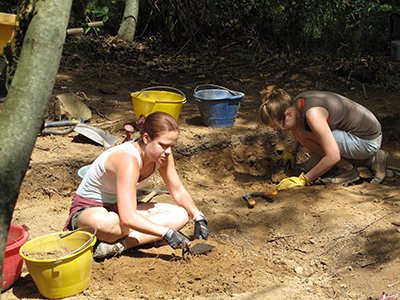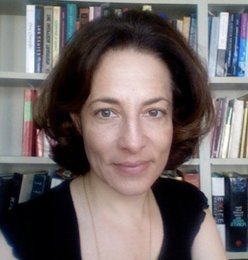Classics Department Guides Students along Career Path

Biology major Veda Khadka ’16 (right) volunteered at the Etruscan archaeological site Poggio Colla in Tuscany this summer.
So what can you actually do with a Classics degree? A lot more than you might think.
That was the theme of a Classics Department gathering earlier this month, at which 40 College community members shared insights on the field’s array of opportunities and career paths. “Eureka!” moments were had and misconceptions dispelled.
“People sometimes have a mistaken image of Classics as a narrow field of Greek and Latin, which just isn’t true,” says Grace Ledbetter, associate professor and chair of the department. “It was exciting to see our students discover just how interdisciplinary our field really is, with a wide variety of disciplinary angles, perspectives, and methodological approaches.”
Bill Beck ’11, Mali Skotheim ’05, and Kyle Khellaf ’08 discussed their classics Ph.D. research on Homer, Greek drama in the Roman Empire, and historiography, casting light on the academic side of the field and some circuitous routes they’ve taken post-Swarthmore.
“Being interested in everything coupled with a deep uncertainty about what I wanted to do with my life led me to some pretty varied experiences,” says Skotheim, who studies at Princeton University. “After college, I worked for a year in a bakery, I worked campaign jobs, and then I worked at Penn for a professor in the microbiology department who liked my Classics background because he collected ancient coins. I discovered printmaking and lived in the studio. I traveled. And then one day I woke up and realized that deep down I really did want to be a Classicist. Taking that time to decide was really important for me.”
The event also featured the perspectives of current students, six of whom recounted archaeology fieldwork they conducted this summer in Greece and Italy — a rare opportunity for undergraduates — and their studies in classical Greek, advanced biblical Greek, and advanced Sanskrit.

Thanks to the support of the Classics Department, Austen Van Burns ’17 spent five weeks excavating a Roman villa in a small town about 40 miles north of Rome.
“The program allowed me to discover a love of archaeology,” says Van Burns, of Salt Lake City, Utah, “a pursuit that mixes the satisfaction of manual labor with the intellectual puzzle of unpacking stratigraphy.”
Also supported by the department was Julia Nee ’15, an Honors ancient history and classical studies major from Duxbury, Mass., who contributed to an archaeological dig in Tuscany for the Roman Peasant Project.
“Besides 'playing in the dirt,’ I had the opportunity to work closely with specialists in archaeology and learn about the documentation side of the field,” she says. “I also learned new technologies like 3D imaging and surveying a site with Total Station.”
Van Burns and Nee are among nearly 100 students enrolled in Classics Department courses this semester, twice as many there were five years ago. By next year, there will be 15 majoring or minoring in Classics, three times more than five years ago. Students can go outside of the department for degree coursework, as well, touching on political science, art history, and religion classes, to name a few.
“They learn how Greco-Roman antiquity has influenced the histories of art, literature, and architecture, even in the contemporary world,” says Ledbetter. “The whole field is opening up, and students see that it’s still a dynamic force today.”
The Classics Department fostered a loose, communal environment for the gathering, which will occur annually. Students relished the chance to glean alumni and faculty perspectives over dinner, but it wasn’t a one-way exchange.
“My favorite part was hearing the students talk about their summer adventures,” says Skotheim. “I was amazed and inspired by the variety of activities that the department supports and that students are taking part in.
“Whatever careers these Classicists decide to pursue,” she adds, “they are sure to be interesting people.”


